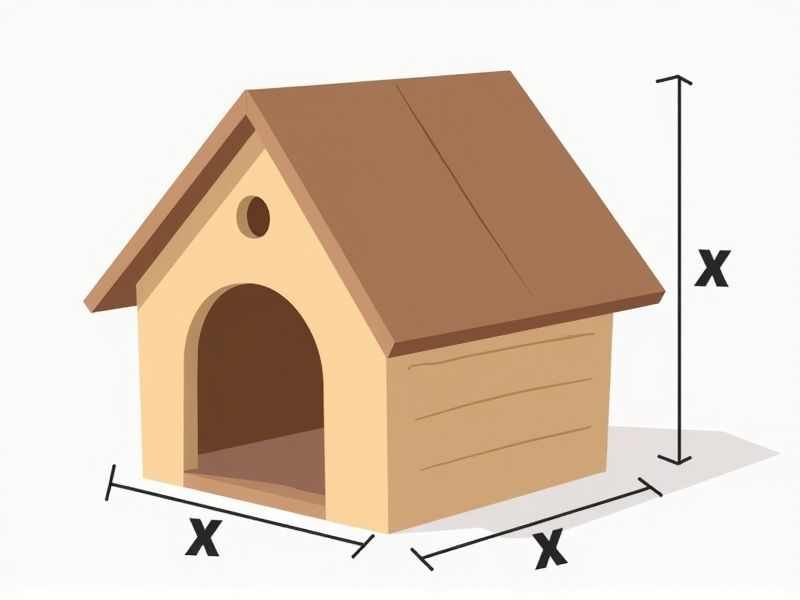
When building or purchasing a doghouse, it's important to ensure the dimensions are appropriate for your dog's size. A common guideline is that the doghouse should be large enough for your dog to stand up, turn around, and lie down comfortably. For example, a standard doghouse for a medium-sized dog (like a Beagle or Cocker Spaniel) might be about 30 inches long, 24 inches wide, and 26 inches high. Always measure your dog and allow a few extra inches on each side to maximize comfort and ventilation.
Appropriate Size For Breed
Choosing the appropriate size for your doghouse is crucial for your pet's comfort and well-being. A doghouse ideally should allow your dog to stand up, turn around, and lie down comfortably; this often means a height of 4 to 6 inches taller than your dog's standing height. For example, a medium-sized breed like a Beagle may require a house approximately 30 inches long, 24 inches wide, and 24 inches high, while a larger breed like a Golden Retriever may need a space of about 42 inches in length, 32 inches in width, and 30 inches in height. Ensuring that the doghouse fits your breed's dimensions can contribute significantly to your dog's happiness and health, preventing stress and discomfort.
Door Height Relative To Dog
The ideal door height for a doghouse should be approximately 75% of your dog's shoulder height to ensure easy entry and exit. For small breeds, this may range from 10 to 14 inches, while larger breeds might require door heights of 18 to 30 inches. It's essential to measure your dog while standing to accurately determine the optimal door dimensions. Ensuring the correct door height not only enhances comfort but also encourages your dog to utilize their shelter freely.
Interior Space For Comfort
A standard doghouse typically measures around 24 to 36 inches in length, 18 to 24 inches in width, and 20 to 30 inches in height, providing ample interior space for your dog to stand, turn around, and lie comfortably. Insulation in the walls and floor can maintain a stable temperature, offering protection during both hot summer months and cold winter nights. Adequate ventilation is crucial, allowing fresh air circulation while preventing moisture buildup, ensuring your pet's comfort and health. Choosing a doghouse with a raised floor can further enhance comfort by keeping your dog dry and sheltered from ground moisture.
Ventilation For Airflow
A well-designed doghouse emphasizes ventilation to ensure optimal airflow, which is crucial for your pet's comfort and health. Proper ventilation can help reduce humidity levels, maintaining a dry environment that prevents mold and odors. Ideal designs include adjustable vents or windows that allow for cross-breezes, enhancing air circulation without exposing your dog to harsh weather conditions. Selecting materials that facilitate airflow, such as wood with natural insulating properties, further contributes to a comfortable living space for your canine companion.
Insulation For Climate
A well-insulated doghouse is essential for maintaining a comfortable environment for your dog, as temperatures can fluctuate significantly. Insulation materials like Styrofoam or rigid foam board can improve energy efficiency, keeping the interior warm during winter and cool in summer. Aim for a doghouse that has a minimum thickness of 1.5 inches of insulation, which can reduce heat loss or gain by up to 50%. Proper ventilation, alongside quality insulation, ensures that your pet remains safe and cozy year-round.
Roof Pitch And Material
The ideal roof pitch for a doghouse ranges from 20 to 30 degrees, providing effective drainage for rain and snow. Materials such as asphalt shingles, metal, or durable plastic are recommended for their weather-resistance and longevity. A well-constructed roof should also ensure adequate ventilation, preventing heat buildup during warmer months. Prioritizing these elements will enhance your dog's comfort and the overall durability of the doghouse.
Floor Elevation Above Ground
The standard floor elevation for a doghouse typically ranges from 4 to 8 inches above ground level, providing necessary protection against moisture and pests. This elevation allows for improved ventilation and helps maintain a comfortable environment for your dog. Building a doghouse with an elevated floor also reduces the risk of flooding during heavy rain. When constructing or purchasing a doghouse, ensure that the design incorporates this essential feature for your pet's health and safety.
Access For Cleaning
An ideal doghouse design emphasizes access for cleaning, ensuring easy maintenance for pet owners. Features such as removable roofs, hinged walls, or sliding floors allow for efficient removal of debris and waste. A well-ventilated doghouse, with dimensions around 30 inches long by 24 inches wide, facilitates air circulation and reduces odor buildup. Prioritizing these cleaning access points contributes significantly to the health and comfort of your dog, promoting a hygienic living environment.
Material Durability
When selecting a doghouse, prioritize materials known for their durability, such as high-quality wood, reinforced plastic, or weather-resistant metals. A well-constructed doghouse should withstand harsh weather conditions, with insulation values ideally between R-20 and R-30 to keep your pet comfortable year-round. Look for water-resistant finishes and UV-protected coatings that extend the lifespan of the structure, ideally increasing durability by 50% or more. Choosing a doghouse made from these robust materials can ultimately enhance your dog's safety and comfort, ensuring it serves well for years.
Aesthetic Design Matching Surroundings
A standard doghouse should seamlessly blend with its surroundings, emphasizing aesthetic design that complements your home or garden. Using natural materials like cedar or pine can enhance durability while providing a visually appealing structure that stands the test of time. The ideal doghouse size accommodates your dog's breed, typically ranging from 24 to 36 inches in height for medium to large breeds, ensuring comfort and protection. Choose colors and styles that resonate with your outdoor decor, creating a harmonious environment for both you and your pet.
